
|
|
|
|
BY: SUN STAFF
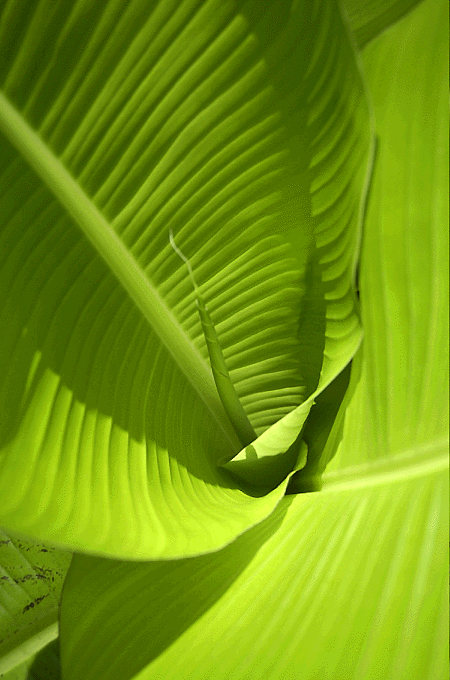
Banana Leaf Jun 11, 2010 — CANADA (SUN) — A journey through India: border to border, bhoga to prasadam. Today we begin a new segment in the Prasadam series, featuring a foodstuff that we may seldom think of as a cooking ingredient: Leaves! There are many kinds of leaves that we refer to simply as vegetables, like spinach, kale, chard and cabbage, all of which are wonderfully used in many dishes. But in this segment, we'll focus more on the non-vegetable leaves – those used for spicing, as wrappings, and a few less familiar leaves that are eaten as greens.
There is a long history of cooking with leaves in Vedic culture, and we find many Sanskrit terms describing the various types of leaves that are eaten or used in the preparation of dishes. Many kinds of leaves are used ceremonially in temple rituals, by brahmanas in various types of offerings, and nearly all of these leaves are also found in prasadam preparations. In Srimad Bhagavatam we read: "Verse fourteen mentions pavitrausadhi. In any ritualistic ceremony, many herbs and leaves were required. These were known as pavitra-patra. Sometimes there were nimba leaves, sometimes bael leaves, mango leaves, asvattha leaves or amalaki leaves. Similarly, there were panca-gavya, panca-sasya and panca-ratna. Although Nanda Maharaja belonged to the vaisya community, everything was known to him. The most important word in these verses is maha-gunam, indicating that the brahmanas were offered very palatable food of exalted quality."
Over the next three parts of this series, we'll offer recipes that feature leaves from the mango, bael, nimba (neem), asvattha (papal), amalaki (amla, or gooseberry), and of course, the banana. Among the tasty edible leaves we'll cover are chauli (amaranth), jackfruit and taro. We'll talk about leaves that are used to wrap other foods for steaming, grilling or baking, including banana, lotus, sugarcane, lemongrass, and sesame. We'll also discuss leaves that are well known flavoring agents, such as bay, lime, curry, methi, and ginseng leaves.
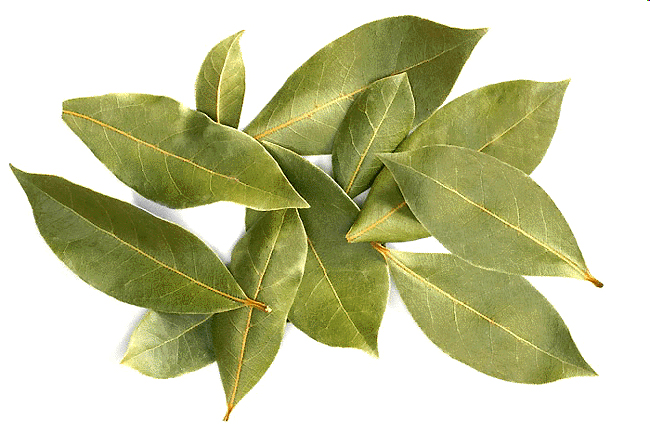
Bay Leaves In the Rasa-tarangini Tika commentary to Verse 44 of Govinda-lilamrta, quoted in earlier segments of the Prasadam series, we find mention of a spicing leaf that is a key ingredient in many favorite Krsna prasadam recipes – the teja, or bay leaf: "These are all various kinds of sharbat (refreshing beverages): Rasala is made from thick milk, yogurt, sugar, cardamom, ghee, honey and black pepper. Shikharini is eight parts yogurt, two parts sugar, one pal of ghee, one pal of honey, one half pal of ground black pepper, one tola of cinnamon, one tola of teja leaves, one tola of cardamom, and one tola of nageshwar. Sarab is made with two parts milk and one part thin yogurt with sugar, cardamom, ghee, honey and black pepper mixed with buttermilk. Matha is buttermilk." Bay leaves go particularly well as a spice in milk-based dishes, both sweet and savory. Banana Leaves Because it is one of the most widely used leaves in Vedic cooking, today we'll focus on the Banana Leaf. These leaves are so broad and long that it's a common practice during the monsoons to hold them upside-down, by the petiole, like an umbrella. The devotees are familiar with the many images of Radha and Krsna out in the monsoon rains, sheltered beneath these excellent leaves. Banana leaves are natural wrappers, and have long been used in tropical locales around the world to wrap food for steaming, grilling, baking and serving. Because banana leaves are so sturdy, and so broad, they make a perfect plate for serving prasadam. The thickness of the leaves keep liquids from soaking through, and foodstuffs look very attractive and delectable against these green leaf plates.
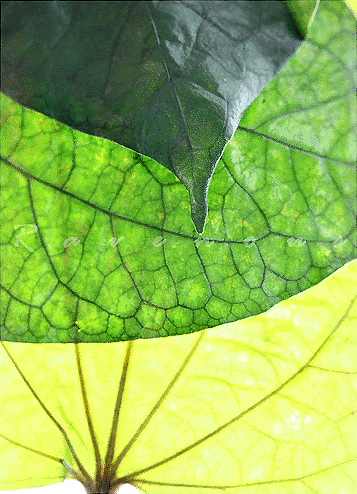
Betel Leaf The banana plant is often mistakenly referred to as a "tree", but in fact it is a large herb, with a succulent and very juicy stem (pseudostem) that is a cylinder of leaf-petiole sheaths. Reaching to a height of up to 25 ft., banana plants are easily recognizable, and readily available in most tropical regions. Even so, banana leaves can fall in short supply. The plants produce only one leaf per month in winter, and just three or four per month in the summer. Banana leaves are not only highly sought after because they're so utilitarian, for wrappings and serving plates, but also because the leaves great value due to their natural constituents. Banana leaves contain large amounts of polyphenols, like EGCG, very similar to green tea, which means they are rich in healthful qualities.
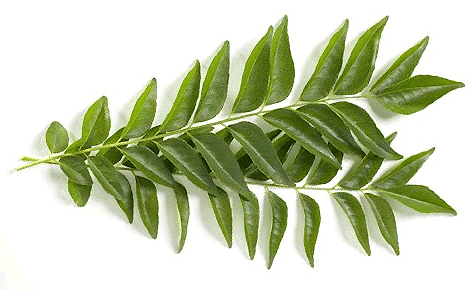
Curry Leaves The leaves also contain a kind of wax, that holds a subtle but wonderful flavor. One of the reasons banana leaves make excellent serving plates is because when hot food is ladled onto them, the waxy substance begins to melt, releasing flavor into the food. This added cachet is particularly noticeable in rice, which easily absorbs the leaf's fragrance. It is also thought that substances are released from the wax that aid in digestion. The banana plant's pseudostem core contains starch, fiber and ash, all of which provide important nutritional value. The ash content in banana leaves, when they are burned, acts like a seasoning salt, and is used to flavor sabjis. This ash is also high in nutrition, containing potassium, magnesium, calcium, and sodium. When the leaves are used as wrappings for grilled food, this ash naturally gets onto the food, increasing the flavor. The young leaf shoots are excellent when cooked as tender greens, and are often prepared as a curry along with potatoes and tomatoes. The tender leaves can also be cut into slices and candied, or treated with citric acid and prepared like chutney.
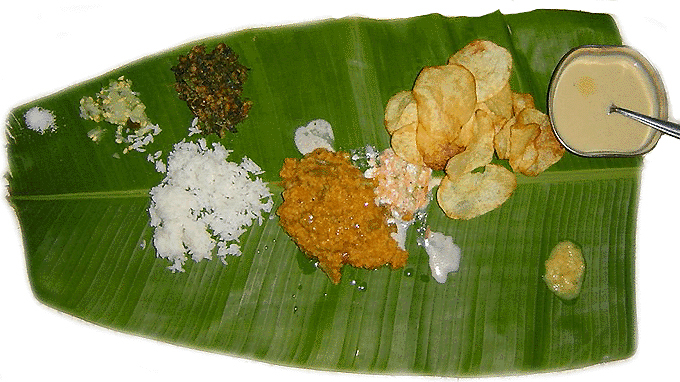
Banana Leaf Plate Banana Leaf Meals In South India, meals are famously served on banana leaves. Called saapad in Tamil, such meals when done properly are elevated to a ritual presentation of prasad, not unlike a formal Bengali feast. The banana leaf is generally used to present a pile of fluffy rice along with an assortment of vegetable sabjis and curries, pickles, raitas, and papadum. Rice is often served with a ladle of rasam or a thin sabji called Tomato Rice, or with other types of dahl. The banana leaf laid in front of an honored guest should be cut from the tip, while pieces from the rest of the leaf are cut for the other members of the gathering. Some parts of the leaf are cut into smaller tiffin-sized pieces, or shapes to be used for wraps. A feast begins with the leaf being sprayed with clean water and wiped down, then a procession of preparations spooned onto the leaf-plate, including payasam, vadai, dry sabjis, wet sabjis, pickle, paruppu, rice and ghee. The four main courses are often sambar, rasam, payasam and curd, and all this is followed by sweets. Preparing Banana Leaves for Cooking In the West, banana leaves are readily available today, both fresh and frozen at Asian and Indian groceries. Before using them, the leaves should be rinsed and dried, cutting away the thick edges and any fibrous stems. The softer leaves are easiest to use because they're the most pliant. Older leaves can easily be softened, however, by lightly steaming or blanching them in boiling water, or by lightly heating them over a flame. If steamed, they should be gently dried before using. As you'll see in the following recipes, the method of using banana leaves as a wrapper for foods that are steamed, baked, grilled, or even chilled is quite simple. There are inconceivable varieties of preparations that can be wrapped and cook or chilled in this way, from sweet to savories.
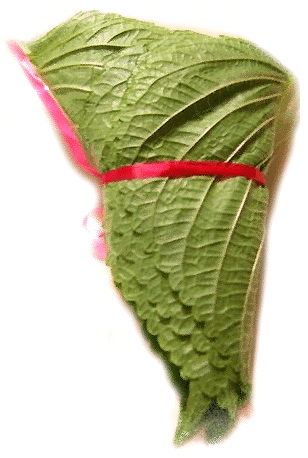
Sesame Leaves
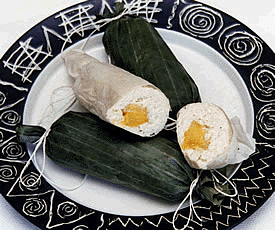
Coconut Rice with Banana and Mango
| |